Microgreen Varieties for the Mississippi Gardener
Growing fresh microgreens is an easy and fun way to enjoy truly locally grown vegetables. They add color and flavor to salads, sandwiches, and main dishes. Microgreens require only a small amount of space and can be grown all year long.

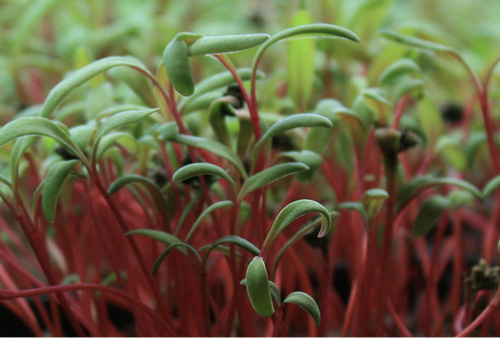

What Are Microgreens?
Microgreens are young, immature, densely grown seedlings of selected vegetables and herbs. At harvest—ranging from 7 to 21 days after germination—microgreens will consist of the stem, cotyledon, and developing true leaves, depending on the species grown.
Benefits of Microgreens
Adding fresh microgreens to your family’s meals is a great way to increase your consumption of important vitamins and phytonutrients. Research has documented that microgreens are packed full of high concentrations of vitamins C and E, beta-carotene, lutein, zeaxanthin, and violaxanthins.
Varieties of Microgreens
There are more than 50 varieties of vegetables and herbs that have been recommended for growing as microgreens. Microgreen seeds should be bought in bulk; it is not economical to use the seed packets available at garden centers. Recommended bulk amounts range from 1 ounce to 1 pound or more depending on the microgreen variety.
Following is a listing of microgreen varieties arranged by their rate of growth from initial seed sowing. Included are variety selections good for home gardeners and tips for growing them successfully. Seed priming can improve the germination and growth of some varieties. For more information on priming microgreen seeds, see Extension Publication 2857 Growing Microgreens for the Mississippi Gardener.
7–10 days
Pea shoots

- Dwarf Grey Sugar pea
- prime seed to promote even germination
- can be recut once
- seeding rate: 6 ounces
- expected yield: 6–8 ounces
Radish


- Hong Vit
- bright green leaves with pink stems
- Red Rambo or Sango
- dark purple stems and leaves; about 20 percent green
- white-, red-, purple-, and green-stemmed varieties available
- distinct spicy radish flavor
- seeding rate: 2 tablespoons
- expected yield: 6–8 ounces
10–15 days
Arugula
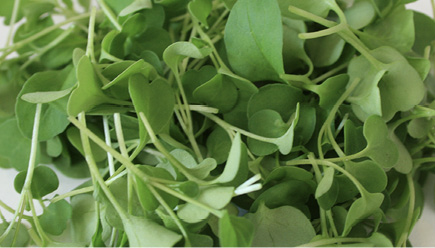
- spicy arugula flavor
- dark green leaves
- seeding rate: 2–3 teaspoons
- expected yield: 3–5 ounces
Broccoli

- bright green
- spicy flavor
- seeding rate: 2–3 teaspoons
- expected yield: 3–5 ounces
Cress

- Cressida
- spicy, peppery flavor
- tri-lobed leaves
- seeding rate: 2–3 teaspoons
- expected yield: 3–5 ounces
Cabbage
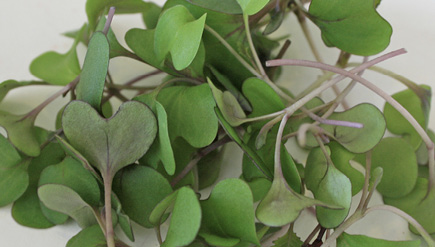

- Red
- mild flavor
- dark green leaves with purple margins
- Kogane
- mildly sweet flavor
- bright green leaves
- seeding rate: 2–3 teaspoons
- expected yield: 4–6 ounces
Greens mix

- mixed greens with various colors and flavors
- typically pac choi, mustard, broccoli, mizuna
- spicy, fresh flavor
- seeding rate: 2–3 teaspoons
- expected yield: 5–7 ounces
Kale

- Blue Curly
- mild spinach-like flavor
- robust grower
- Red Russian
- mild flavor
- dark blue-green, serrated leaves outlined in pink
- seeding rate: 2–3 teaspoons
- expected yield: 4–6 ounces
Mustard
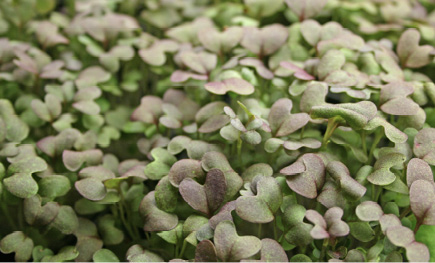
- Ruby Streaks
- red and dark green leaves
- light green stems
- spicy flavor
- seeding rate: 2–3 teaspoons
- expected yield: 4–6 ounces
Pac choi


- Pac Choi
- bright white stems
- green leaves
- Red Choi
- dark green leaves
- maroon veins
- mild flavor
- seeding rate: 2–3 teaspoons
- expected yield: 4–6 ounces
Purple kohlrabi
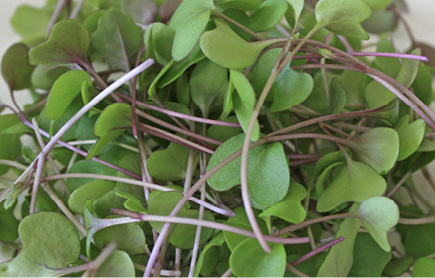
- purple stems
- dark green leaves with a purple tint
- mild flavor
- seeding rate: 3 teaspoons
- expected yield: 2–4 ounces
16–25 days
Amaranth

- Red Garnet
- mild flavor
- attractive fuchsia stems and leaves
- needs to be grown very dry
- adds spectacular color to dishes
- seeding rate: 1 teaspoon
- expected yield: 2–3 ounces
Basil


- Italian Large Leaf
- basil flavor
- green stems and leaves
- Dark Opal
- basil flavor
- mostly purple leaves with 20 percent variegated or green leaves
- Mrs. Burns Lemon
- very bright green
- sweet, tangy lemon flavor
- Lime
- bright green
- unique lime-citrus flavor for fish or salads
- seeding rate: ½–1 teaspoon
- expected yield: 2–4 ounces
Beets



- Bull’s Blood
- mild beet flavor
- deep burgundy leaves
- red stems
- Early Wonder
- mild beet flavor
- medium green leaves
- red stems
- Yellow
- mild beet flavor
- light green leaves
- yellow mid-vein and stems
- seed hulls are hard and need to be removed before eating
- prime seed to promote even germination
- seeding rate: 3–5 tablespoons
- expected yield: 3–6 ounces
Carrot

- carrot flavor
- fine-textured leaves
- seeding rate: 1 teaspoon
- expected yield: 2–3 ounces
Cilantro

- Santo Monogerm
- split seeds for precise planting
- Cilantro “seeds” are actually fruits that contain two or more seeds. Monogerm seeds are split in half, allowing for more even germination.
- prime seed to promote even germination
- leave seed hull on for a hint of coriander flavor
- seeding rate: 1 tablespoon
- expected yield: 4–5 ounces
Cutting celery

- bold celery flavor for salads, soups, and stews
- seeding rate: 1 teaspoon
- expected yield: 2–3 ounces
Parsley

- intricate lobed leaves
- mild parsley flavor
- seeding rate: 2 teaspoons
- expected yield: 2–3 ounces
Scallions

- Evergreen Hardy White
- onion flavored
- green threads
- can be recut several times at about 2-week intervals
- prime seed to promote even germination
- seeding rate: 2 tablespoons
- expected yield: 2–3 ounces
Swiss chard


- Ruby Red
- candy-apple red stems
- dark green, red-veined leaves
- Rainbow, Bright Lights
- gold, pink, orange, purple, red, and white with bright and pastel variations
- seed hulls are hard and need to be removed before eating
- prime seed to promote even germination
- seeding rate: 3–5 tablespoons
- expected yield: 3–6 ounces
The information given here is for educational purposes only. References to commercial products, trade names, or suppliers are made with the understanding that no endorsement is implied and that no discrimination against other products or suppliers is intended.
Publication 2884 (POD-05-24)
Reviewed by Ibukun Timothy Ayankojo, PhD, Assistant Professor, North Mississippi Research and Extension Center. Written by Gary R. Bachman, PhD, Extension/Research Professor Emeritus, Coastal Research and Extension Center.
The Mississippi State University Extension Service is working to ensure all web content is accessible to all users. If you need assistance accessing any of our content, please email the webteam or call 662-325-2262.


